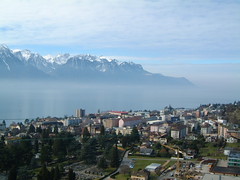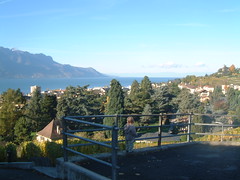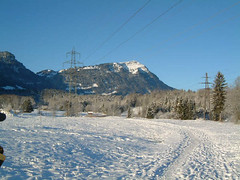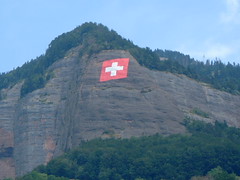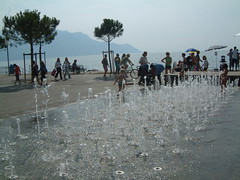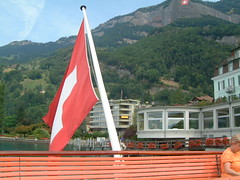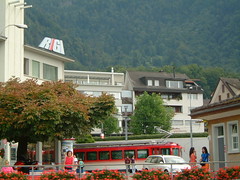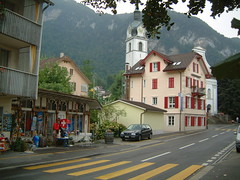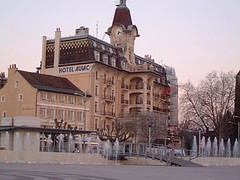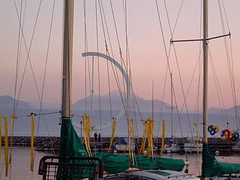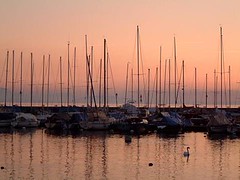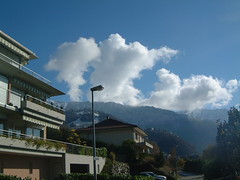Car Travel in SwitzerlandTravelling by car in Switzerland is very convient, as villages and towns are very well marked and accessable. The road conditions are excellent in the summers and in the winters. All green road signs indicate an autobahn, better known as the highway to English speakers, blue signs are secondary roads and white signs back roads.
Car travel in Switzerland is far different than by traveling via train. My first four months in Switzerland, I only saw Switzerland by train. Once I had gone for a Car ride, I was shocked at the differences I saw. Both are quite impressive.
One useful tidbit of information if you decide to travel by car is that the highways are subject to a toll, but not really in the same way one might think. There is a vignette (better known as a sticker) which you must put somewhere on your car. These little stickers can be bought in gas stations or at the customs office.
The cost is about sFr. 40- and valid for one year. Don't even think about trying to steal one of these stickers. They stick like glue and are far too hard to remove without anything but rasor blade.
You must obtain a separate vignette for a trailer or caravan. If your vehicle doesn't bear a properly affixed vignette and the Swiss police catch you driving on an expressway, you'll be subject to a 100 sFr fine-on top of the vignette's cost. They are usually very slacked in the first month of the new year.
SpeedThe speedlimit is 120 km/h (74 mph) on the autobahn, 100km in tunnels, 80 km/h (50 mph) on secondary roads outside of towns and 50 km/h (30 mph) in towns if not indicated differently. Roadside automatic radar-triggered cameras help enforce these limits. Police are empowered to collect fines on the spot. Some areas are much more harsh on speeding. The canton of Aarau dones not have a single radar camera. My Swiss friend explained the reason to me, but basically it was because they voted against it.
Now this might sound scary but basically the most popular areas will have a radar camera. If you are driving on the autobahn, most Swiss will slow down in these areas, kinda giving you a sign that a radar is near.
You will find the speed limits are quite fast. But make sure you obey the rules of the road. Nobody is to drive on the left lane unless you are passing. The right hand lane is reserved for slower vehicles. If you find yourself driving in the left lane more often than not, watch out because you will probably find a faster car behind you wanting to get by. The Swiss are quite good drivers.
Some helpful need to know hintsFor travellers with motorhomes it's to say, that even large motorhomes can travel through the alp passes. the roads are well maintained and large enough even for trucks. Many Dutch seem to prefer this method of traveling.
Remember, Switzerland is a very small Country (ca. 250x400 km) and you can easely drive from one end to another in 3 - 5 Hours if you stick to the highways. If you plan to travel Switzerland by car, take your time, you can plan to see lots of places in a short amount of time. But make sure you compensate for those mountains or you will find your trip taking longer than you thought. No destination is just a straight drive from destination A to B.
The minimum age of a driver is 18 years. Seat belts are compulsory for front and rear-seat passengers. The legal blood alcohol limit is 0.08 .
The mountain resort towns of Braunwald, Murren, Wengen and Zermatt cannot be reached directly by private motor vehicle. Park at the railway or sky tram station and complete the journey via public transport.
Trams always have priority. Buses have priority when leaving a bus stop. Traffic going up a mountain has priority. Some mountain roads require one-way traffic during certain hours only; these hours will be posted at either end of such roads. Remember there are also many round abouts. You must signal when you exit out, with priority to your right.
Parking
Many towns have Blue Zones that restrict parking during the period 8am to 7pm on weekdays. Obtain discs free of charge from ACS or TCS motoring club offices or at fuel stations, kiosks, police stations, and garages. Wheel clamps are in use and can be a rude awakening if you don't follow the parking procedures. Ask others if you are not sure!
Fuel stations along expressways are usually open from 6:00 a.m. to 10pm or midnight. Outside of open hours fuel is commonly available from automatic pumps that accept 10 and 20 sFR bills or credit cards from the pay machines (same as in a normal self service pump). Many stations accept major charge cards like Visa, MasterCard or American Express.
Only unleaded fuel is available in 95 or 98 octan. Unleaded petrol is called bleifrei, essence sans plomb, or benzina sensa piomba. Diesel is called diesel and LPG is called autogas.
Prizes for bleifrei range from SFr. 1.35.- to 1.50.- depending on the oil price. Disel is usually a bit more expensive, but well worth it.


